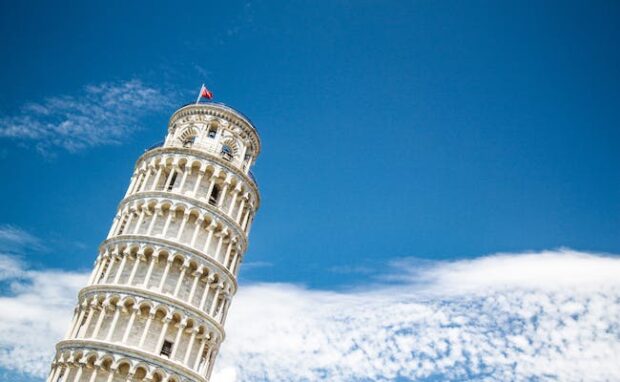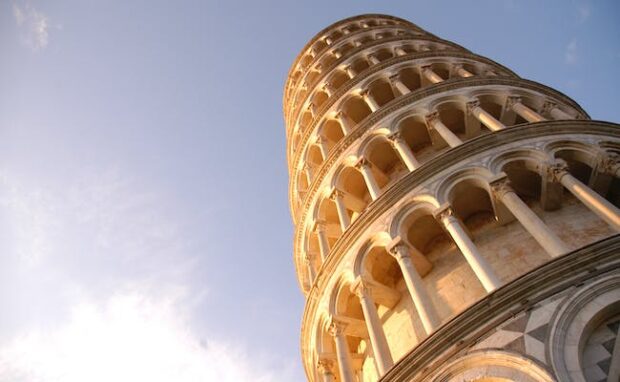Leaning Tower of Pisa on red alert for collapse
Bologna City in Italy put the Leaning Tower of Pisa on high alert to protect people from a possible collapse. The local government has installed a cordon to keep people at a distance and placed rockfall protection nets. However, a spokesperson told CNN it isn’t on the verge of immediate collapse. Instead, they are just preparing for the worst-case scenario.
The Leaning Tower of Pisa was one of the Seven Wonders of the World. It is one of Italy’s recognizable landmarks, inspiring many to take pictures of themselves seemingly trying to push it back. Consequently, you may want to learn more about it before it collapses.
This article will discuss why the local government issued a red alert warning for the Leaning Tower of Pisa’s collapse. Then, I will elaborate on its history briefly to help readers appreciate this structure further.
Why is the Leaning Tower of Pisa on high alert?

The experts monitoring the structure put it on “high alert” because they “believe that safety conditions no longer exist to operate on or around the tower, except within the framework of a civil protection plan.”
They issued a 27-page report detailing its structural risks. It says analyses revealed an “unexpected and accelerated trend” of “crushing” compression to the base of the tower, with gradual disintegration of the stone used to clad the base and cracks expanding in the brick above.
The report reveals the tower has been in an “inescapably critical condition for some time.” It suggests previous interventions, such as the “hoop” of steel rods and cables around the base, have exacerbated the situation.
“The overall situation has unfortunately worsened considerably, with worrying implications for the overall stability of the tower,” the report states.
“The unexpected and accelerated trend leads the committee to immediately suspend all activities currently underway (especially consolidation) and to put the site on high alert. [The committee believes] that safety conditions no longer exist to operate on or around the tower, except within the framework of a civil protection plan.”
You may also like: Parmesan makers fight fakes with microchips
As mentioned, a spokesperson told CNN the tower isn’t going to collapse soon. However, “We’re acting as if it’s about to collapse, but nobody knows when that could be – it could be three months, 10 years, or 20 years.”
“If there was an imminent risk of collapse, we’d evacuate everyone,” he added. Also, WHDH News said monitoring delivers readings every 15 minutes, meaning the local government will immediately evacuate everyone if it collapses soon.
The spokesperson says new research will begin once the Leaning Tower’s cordon finishes. It will find a solution to stabilize the tower and resolve its underlying problem.
What’s the origin of the Leaning Tower of Pisa?

The Tower’s possible collapse renewed the world’s interest, so it’s an opportune time to learn more about it. The Florence Museum website said the Leaning Tower of Pisa took three stages and 177 years to build.
Architect Bonanno Pisano began construction in 1173. He surrounded the first floor with 15 columns in white marble with blind arches and classic capitals.
However, he built the tower on unstable subsoil, so he had problems when he installed the third floor. It bent 5 cm to the southeast, prompting crews to halt construction.
You may also like: What we know about Apple AirTags
A hundred years later, Giovanni di Simone resumed work by trying to compensate for the tower’s inclination. However, the bell tower was still leaning, stopping work again.
Six decades later, Tommaso Pisano continued building the bell tower. In 1372, he finished constructing the Leaning Tower of Pisa.
In 1835, architect Alessandro Gherardesca made the first restoration by eliminating the muddy soil and replacing it with a marble surface. However, that only increased the tower’s tilt!
Conclusion
The Leaning Tower of Pisa is on a red alert warning because it has a risk of collapsing. However, a local spokesperson told the public it will not crash down soon.
It is only a preventative measure to ensure people are safe. Meanwhile, experts are figuring out how to repair the tower. “Some say let’s dismantle it, redo the base and rebuild it. Others say let’s trim it [the tower itself] as was done in the medieval period,” he said.
“These are all hypotheses that we’re studying – the tower is nearly 1,000 years old, and there’s no rulebook,” he added. Learn more about the latest digital tips and trends at Inquirer Tech.